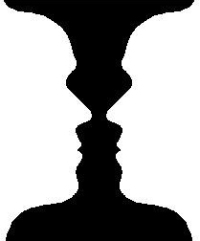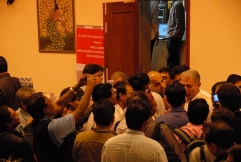|
It's an impossible task selecting the good ones because they're all great. Whoever's pointing this camera knows exactly what they're doing. These aren't merely happy snaps, kind of like those you begrudgingly and patiently, stoically sit through for someone's boring vacation show and tell. These photographs prove photography as an art form. And what they each depict is equally artful. They each show, in their own way, human beings fully engaged, fully communicating, joyfully expressing relationship as the source of who we really are. And as I'm sorting through each of them, mentally I'm making notes to set aside showing the protagonist, the one around whom the crowd's milling, the one on whom all foci are converging. The photograohs showing him and his interactions and his inter‑re‑actions with the crowd are clearly the money shots.
... or so it would seem ... at first. These are the ones, the seventy or so I choose for a project I'm working on. I choose them because they depict source. I choose them because they show language as the inspiration for human beings fully engaged, fully communicating, joyfully expressing relationship as the source of who we really are. This is the core set I want for my project: only the ones which show him.

